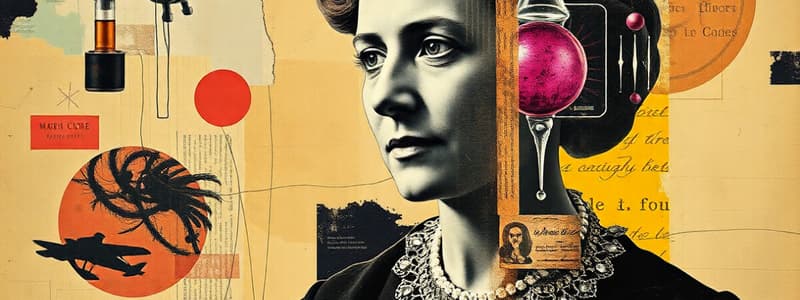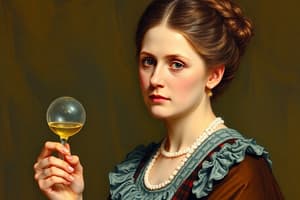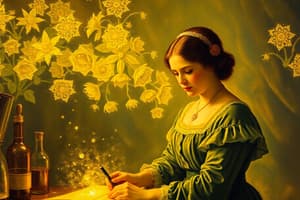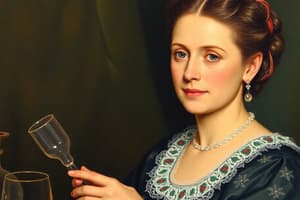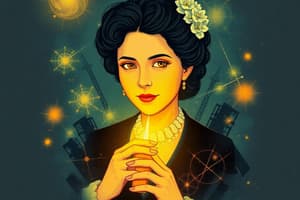Podcast
Questions and Answers
What motivated Marie Curie to study uranium ore alongside her husband Pierre?
What motivated Marie Curie to study uranium ore alongside her husband Pierre?
- A competition between scientists in Europe
- A desire to invent new elements for commercial use
- A need to validate Pierre's work in nuclear physics
- An interest sparked by Henri Becquerel's discovery of radioactivity (correct)
What were the two new radioactive elements discovered by the Curies?
What were the two new radioactive elements discovered by the Curies?
- Thorium and Radon
- Uranium and Plutonium
- Cesium and Barium
- Radium and Polonium (correct)
In what year did Marie Curie win her first Nobel Prize and in which field?
In what year did Marie Curie win her first Nobel Prize and in which field?
- 1901 in Chemistry
- 1915 in Medicine
- 1911 in Chemistry
- 1903 in Physics (correct)
What significant term did the Curies introduce to the scientific community?
What significant term did the Curies introduce to the scientific community?
Which of the following describes Marie Curie’s achievements regarding Nobel Prizes?
Which of the following describes Marie Curie’s achievements regarding Nobel Prizes?
What was the primary substance Henri Becquerel was investigating when he discovered natural radioactivity?
What was the primary substance Henri Becquerel was investigating when he discovered natural radioactivity?
Which of the following achievements is associated with Marie Curie's research?
Which of the following achievements is associated with Marie Curie's research?
What significant term did Marie Curie coin to describe the energy released during atomic disintegration?
What significant term did Marie Curie coin to describe the energy released during atomic disintegration?
What was one of the dangers associated with the handling of radioactive substances that Curie and other scientists faced?
What was one of the dangers associated with the handling of radioactive substances that Curie and other scientists faced?
What did Henri Becquerel use to demonstrate the emission of radiation from uranium?
What did Henri Becquerel use to demonstrate the emission of radiation from uranium?
What significant contribution did Marie Curie make during World War I?
What significant contribution did Marie Curie make during World War I?
What resulted from Marie Curie's long-term exposure to radiation?
What resulted from Marie Curie's long-term exposure to radiation?
Which of the following statements about Marie Curie's early life is true?
Which of the following statements about Marie Curie's early life is true?
Which organization did Marie Curie help establish to focus on cancer treatment?
Which organization did Marie Curie help establish to focus on cancer treatment?
What was the price of one gram of radium in 1921?
What was the price of one gram of radium in 1921?
Which of the following correctly identifies the two types of radiation discovered by Rutherford?
Which of the following correctly identifies the two types of radiation discovered by Rutherford?
What was the primary significance of Rutherford's 1911 atomic model?
What was the primary significance of Rutherford's 1911 atomic model?
How did Rutherford demonstrate the disintegration of elements in his 1899 research?
How did Rutherford demonstrate the disintegration of elements in his 1899 research?
What element did Rutherford transform into oxygen during his experiments?
What element did Rutherford transform into oxygen during his experiments?
What was Rutherford's primary contribution that led to him winning the Nobel Prize in Chemistry in 1908?
What was Rutherford's primary contribution that led to him winning the Nobel Prize in Chemistry in 1908?
What does Rutherford’s discovery of alpha particles indicate about their charge?
What does Rutherford’s discovery of alpha particles indicate about their charge?
Where did Ernest Rutherford conduct significant research that led to his Nobel Prize?
Where did Ernest Rutherford conduct significant research that led to his Nobel Prize?
What was a notable aspect of Rutherford's quote, 'I have broken the machine and touched the ghost of matter'?
What was a notable aspect of Rutherford's quote, 'I have broken the machine and touched the ghost of matter'?
What year did Egas Moniz publish his first paper on angiography?
What year did Egas Moniz publish his first paper on angiography?
What procedure was developed by Egas Moniz to address certain mental illnesses?
What procedure was developed by Egas Moniz to address certain mental illnesses?
What tool did Moniz invent for his psychosurgery technique?
What tool did Moniz invent for his psychosurgery technique?
Which of the following conditions was not commonly treated with lobotomy in the era of Egas Moniz?
Which of the following conditions was not commonly treated with lobotomy in the era of Egas Moniz?
In what year did Moniz receive the Nobel Prize in Physiology or Medicine?
In what year did Moniz receive the Nobel Prize in Physiology or Medicine?
What was the fate of many patients who underwent lobotomies performed by Moniz?
What was the fate of many patients who underwent lobotomies performed by Moniz?
What event nearly ended Moniz's life in 1939?
What event nearly ended Moniz's life in 1939?
What significant work did Einstein complete in 1915?
What significant work did Einstein complete in 1915?
What imaging technique did Moniz establish that was the standard until 1975?
What imaging technique did Moniz establish that was the standard until 1975?
What action did Einstein take in response to the rise of Nazism in Germany?
What action did Einstein take in response to the rise of Nazism in Germany?
Which of the following was a result of Einstein’s work published in 1905?
Which of the following was a result of Einstein’s work published in 1905?
What significant contribution led to Einstein being awarded the Nobel Prize in Physics in 1921?
What significant contribution led to Einstein being awarded the Nobel Prize in Physics in 1921?
What distinguished Einstein's early career before achieving global recognition?
What distinguished Einstein's early career before achieving global recognition?
What conclusion did Rutherford reach from his experiment with alpha particles?
What conclusion did Rutherford reach from his experiment with alpha particles?
What was the primary model of the atom before Rutherford's findings?
What was the primary model of the atom before Rutherford's findings?
How did Rutherford describe his model of the atom in relation to a solar system?
How did Rutherford describe his model of the atom in relation to a solar system?
What did Niels Bohr contribute to the understanding of atomic structure?
What did Niels Bohr contribute to the understanding of atomic structure?
What discovery did Rutherford make regarding the nucleus and its composition?
What discovery did Rutherford make regarding the nucleus and its composition?
Which element was found to be released when Nitrogen was bombarded with alpha particles in Rutherford's experiments?
Which element was found to be released when Nitrogen was bombarded with alpha particles in Rutherford's experiments?
Who identified neutrons and when?
Who identified neutrons and when?
In what year did Rutherford publish his model of the atom?
In what year did Rutherford publish his model of the atom?
What significant term did Lise Meitner coin that relates to nuclear science?
What significant term did Lise Meitner coin that relates to nuclear science?
In what year did Lise Meitner publish her theory of nuclear fission?
In what year did Lise Meitner publish her theory of nuclear fission?
What factor allowed Lise Meitner to pursue higher education in physics despite restrictions on women at the time?
What factor allowed Lise Meitner to pursue higher education in physics despite restrictions on women at the time?
Which prestigious award was Lise Meitner awarded in 1966?
Which prestigious award was Lise Meitner awarded in 1966?
Who was Lise Meitner's noted mentor during her doctoral studies at the University of Vienna?
Who was Lise Meitner's noted mentor during her doctoral studies at the University of Vienna?
What was Lise Meitner's area of research that contributed to her earning a doctorate?
What was Lise Meitner's area of research that contributed to her earning a doctorate?
What was a significant event in Lise Meitner's life in 1938?
What was a significant event in Lise Meitner's life in 1938?
What hindered Lise Meitner's ability to witness the results of her nuclear fission experiments after fleeing Germany?
What hindered Lise Meitner's ability to witness the results of her nuclear fission experiments after fleeing Germany?
What is a key characteristic of Bose-Einstein condensates (BECs)?
What is a key characteristic of Bose-Einstein condensates (BECs)?
Which of the following theories was NOT developed by Albert Einstein?
Which of the following theories was NOT developed by Albert Einstein?
What phenomenon did Einstein's explanation of the photoelectric effect help to establish?
What phenomenon did Einstein's explanation of the photoelectric effect help to establish?
In which year were Bose-Einstein condensates first produced?
In which year were Bose-Einstein condensates first produced?
Einstein's famous equation E = mc² illustrates the relationship between what two concepts?
Einstein's famous equation E = mc² illustrates the relationship between what two concepts?
What did the observation of light bending during a solar eclipse in 1919 confirm?
What did the observation of light bending during a solar eclipse in 1919 confirm?
What property of special relativity explains the relationship between space and time?
What property of special relativity explains the relationship between space and time?
Which state of matter does Bose-Einstein condensate represent?
Which state of matter does Bose-Einstein condensate represent?
What was Lise Meitner's primary contribution to the field of nuclear physics?
What was Lise Meitner's primary contribution to the field of nuclear physics?
Which of the following best describes Meitner's recognition in relation to the Nobel Prize?
Which of the following best describes Meitner's recognition in relation to the Nobel Prize?
What breakthrough did Meitner and Hahn achieve together in their early career?
What breakthrough did Meitner and Hahn achieve together in their early career?
Which other physicist was mentioned alongside Lise Meitner and what is he known for?
Which other physicist was mentioned alongside Lise Meitner and what is he known for?
What perspective did Lise Meitner hold about science despite the lack of recognition for her work?
What perspective did Lise Meitner hold about science despite the lack of recognition for her work?
What major scientific concept did Meitner and Frisch discover together?
What major scientific concept did Meitner and Frisch discover together?
In what year did Lise Meitner become the first female physics professor in Germany?
In what year did Lise Meitner become the first female physics professor in Germany?
What was the nature of the results Hahn reported to Meitner that led to their discovery?
What was the nature of the results Hahn reported to Meitner that led to their discovery?
Flashcards
Natural Radioactivity
Natural Radioactivity
The phenomenon where a substance emits radiation without external energy input, like the uranium Becquerel studied.
Henri Becquerel
Henri Becquerel
A scientist who discovered the process of natural radioactivity by studying uranium, leading to the Nobel Prize with Pierre and Marie Curie.
Radioactive Decay
Radioactive Decay
The process where the nucleus of an atom releases radiation, leading to its transformation.
Becquerel (Bq)
Becquerel (Bq)
A unit of measurement for radioactivity, named after Henri Becquerel, the discoverer of natural radioactivity.
Signup and view all the flashcards
Electrons
Electrons
The negatively charged particles that orbit the nucleus of an atom, identified and described by Thomson.
Signup and view all the flashcards
Protons
Protons
The positively charged particles that make up the nucleus of an atom, discovered by Rutherford.
Signup and view all the flashcards
Protons
Protons
The positively charged particles that make up the nucleus of an atom, discovered by Rutherford.
Signup and view all the flashcards
Nuclear Fission
Nuclear Fission
The splitting of an atom's nucleus into smaller parts, releasing huge amounts of energy, discovered by Lise Meitner and Otto Hahn.
Signup and view all the flashcards
Nuclear Transmutation
Nuclear Transmutation
The process of changing one element into another, discovered by Rutherford.
Signup and view all the flashcards
Rutherford Model of the Atom
Rutherford Model of the Atom
The model of an atom where electrons orbit a central nucleus, proposed by Rutherford based on his experiments.
Signup and view all the flashcards
Ernest Rutherford
Ernest Rutherford
A scientist who revolutionized our understanding of the atom, discovering protons, alpha and beta radiation, and nuclear transmutation.
Signup and view all the flashcards
Niels Bohr
Niels Bohr
A scientist who proposed that electrons exist in specific energy levels, or 'shells', around the nucleus, explaining how atoms absorb and emit energy.
Signup and view all the flashcards
Bohr Model
Bohr Model
The theory explaining that electrons exist in specific energy levels around the nucleus, based on quantum mechanics.
Signup and view all the flashcards
Atoms
Atoms
The particles that make up matter, primarily protons, neutrons, and electrons.
Signup and view all the flashcards
Radioactive Decay
Radioactive Decay
The process where an unstable atomic nucleus loses energy by emitting particles, changing its own identity.
Signup and view all the flashcards
Gamma Radiation
Gamma Radiation
The type of radiation composed of high-energy photons, discovered by Rutherford.
Signup and view all the flashcards
Beta Radiation
Beta Radiation
The type of radiation composed of high-energy electrons, discovered by Rutherford.
Signup and view all the flashcards
Alpha Radiation
Alpha Radiation
The type of radiation composed of helium nuclei, discovered by Rutherford.
Signup and view all the flashcards
Atomic Nucleus
Atomic Nucleus
The positively charged center of an atom, containing protons and neutrons, discovered by Rutherford.
Signup and view all the flashcards
Quantum of Energy
Quantum of Energy
The unit of energy equal to the energy contained in a single photon of a specific frequency, discovered by Planck.
Signup and view all the flashcards
António Egas Moniz
António Egas Moniz
A scientist who made significant contributions to brain imaging and psychosurgery, developing the angiogram and lobotomy.
Signup and view all the flashcards
Angiography
Angiography
A type of X-ray procedure used to visualize blood vessels, invented by Moniz.
Signup and view all the flashcards
Lobotomy
Lobotomy
A type of psychosurgery involving cutting connections in the frontal lobes of the brain, pioneered by Moniz.
Signup and view all the flashcards
Bose-Einstein Condensation
Bose-Einstein Condensation
The term referring to the process of changing a substance's state of matter from a gas to a very cold superfluid state, discovered by Bose.
Signup and view all the flashcards
Satyendra Nath Bose
Satyendra Nath Bose
A scientist who made significant contributions to quantum mechanics, predicting the Bose-Einstein Condensation, a fifth state of matter.
Signup and view all the flashcards
Albert Einstein
Albert Einstein
A scientist born in Ulm, Germany, who changed our understanding of gravity, space-time, and the relationship between mass and energy.
Signup and view all the flashcards
Special Relativity
Special Relativity
The theory explaining that the laws of physics are the same for all observers in uniform motion, including the speed of light, developed by Einstein.
Signup and view all the flashcards
General Relativity
General Relativity
The theory explaining gravity as a curvature in space-time caused by massive objects, developed by Einstein.
Signup and view all the flashcards
Marie Curie
Marie Curie
A scientist who was born in Warsaw, Poland, and became the first woman to win a Nobel Prize and the first person to win it twice, in Physics and Chemistry.
Signup and view all the flashcards
Marie Curie
Marie Curie
A scientist who helped to establish the Curie Foundation for cancer research using radium, driving a truck with X-ray equipment for soldiers in World War I.
Signup and view all the flashcards
Neutrons
Neutrons
The particles in an atom that have no charge and reside in the nucleus.
Signup and view all the flashcards
Lise Meitner
Lise Meitner
A scientist who was born in Vienna, Austria, and coined the term 'nuclear fission', explaining the splitting of uranium atoms, but did not win the Nobel Prize for the discovery.
Signup and view all the flashcardsStudy Notes
Marie Curie
- Marie Curie, born Maria Skłodowska in Warsaw, Poland, in 1867, faced significant obstacles in her pursuit of scientific knowledge.
- Due to societal limitations against women's education, she had to study in secret and save money to attend the Sorbonne in Paris.
- She met and married Pierre Curie, a physicist, and they began a scientific partnership that would revolutionize understanding of radioactivity.
- Curie and her husband, Pierre, were fascinated by Henri Becquerel's discovery of radioactivity and dedicated their research to the study of uranium ore.
- Their research led to the discovery of two new radioactive elements: Polonium (named after Poland) and Radium.
- The pair's groundbreaking discovery earned them, along with Becquerel, the 1903 Nobel Prize in Physics.
- Curie and her husband, Pierre, conducted landmark research and published jointly.
- They are credited with coining the term "radioactivity" and establishing the field of atomic physics.
- Curie's work also advanced cancer treatment by collaborating with André-Louis Debierne to isolate radium for therapeutic applications.
- In 1911, Curie became the first person to win a Nobel Prize twice, this time for Chemistry.
- During World War I, Curie used money from her Nobel Prize to fund 20 mobile X-ray units, nicknamed "Petites Curies," for battlefield use.
- She drove one of the trucks herself to scan wounded soldiers.
- Curie helped establish the Curie Foundation to research cancer treatment using radium.
- She toured the United States twice to raise money for this research.
- Curie's prolonged exposure to radiation contributed to her death from aplastic anemia at age 66.
Henri Becquerel
- Becquerel (1852-1908) was interested in phosphorescence and wanted to see if there was a connection between phosphorescence and X-rays.
- He took a salt containing uranium, which glowed after exposure to light, and placed it on photographic plates.
- He left these in a dark drawer overnight and the next day found the plates exposed, proving that the uranium had emitted radiation.
- His discovery of natural radioactivity earned him the 1903 Nobel Prize in Physics, shared with Pierre and Marie Curie.
- In recognition of his work, the unit of radioactivity is named after him: the becquerel.
Ernest Rutherford
- Rutherford's research transformed our understanding of the atom, identifying its components and revealing its inner structure.
- He demonstrated that atoms can disintegrate into smaller constituents, and described two types of radiation: gamma and beta radiation.
- He published his discovery of alpha and beta radiation, and the disintegration of elements in 1899.
- He proposed the Rutherford model of the atom, stating that electrons orbit a tiny nucleus.
- Rutherford discovered the proton and transformed one element into another through nuclear fission.
- He won the Nobel Prize in Chemistry in 1908.
- He performed the first transmutation of elements by bombarding nitrogen atoms with alpha particles, causing them to transform into oxygen atoms.
- Rutherford was born into a farming family in Brightwater, New Zealand.
- He earned a scholarship to Canterbury College (now the University of Canterbury), and later a scholarship to Cambridge University, where he worked with J.J. Thomson.
- Thomson recommended Rutherford for a professorship in physics at McGill University in Montreal, Canada.
Niels Bohr
- Along with Rutherford, Bohr helped understand atomic structure.
- He explained that electrons could only exist in specific energy levels or "shells" orbiting the nucleus.
- Electrons could change energy levels by absorbing or emitting defined packets of energy (quanta).
António Egas Moniz
- Moniz, a highly regarded Portuguese neurologist, made significant contributions to brain imaging and psychosurgery.
- His work profoundly impacted psychiatry in the 1940s and 1950s.
- In 1927, Moniz invented the angiogram, a type of X-ray used to visualize blood vessels, enabling the identification of brain tumors.
- Moniz was a pioneer in psychosurgery.
- He developed a technique called lobotomy (or leucotomy), involving a needle and a wire loop (leucotome) to cut through the connections of the frontal lobes.
- His groundbreaking work earned him the Nobel Prize in Physiology or Medicine in 1949, for the invention of prefrontal lobotomy.
Lise Meitner
- Meitner, an Austrian theoretical nuclear physicist, coined the term "nuclear fission" and developed the theory explaining the splitting of uranium atoms' nuclei.
- She was born in Vienna, Austria, the third of eight children.
- Her father, a lawyer, fostered an intellectually stimulating environment at home.
- She showed an early aptitude for mathematics.
- She became one of the first women to enter the University of Vienna's physics program.
- She earned her doctorate and became the second woman at the university to receive a physics doctorate.
- She moved to Berlin to work as a departmental assistant at Max Planck's physics institute.
- She was awarded the Leibniz Medal and became the head of the physics department at the University of Berlin.
- She escaped Nazi Germany and settled in Sweden.
- She published, along with her nephew Otto Frisch, the theory of nuclear fission in Nature on February 11, 1939.
- She was awarded the Enrico Fermi Award by the US Atomic Energy Commission, along with Otto Hahn and Fritz Strassmann.
- Meitner helped to create the theoretical basis for nuclear fission, but the 1944 Nobel Prize for the discovery of nuclear fission was awarded to Hahn alone.
Albert Einstein
- Einstein was born in Ulm, southern Germany, to Jewish parents.
- He showed a talent for mathematics from a young age.
- He published four scientific papers in 1905 that garnered significant attention from academics worldwide.
- His work as a professor at the University of Berlin led to the publication of "General Theory of Relativity" in 1915.
- He was awarded the Nobel Prize in Physics in 1921 for his contributions to theoretical physics.
- He emigrated to the US in 1933 due to the rise of Nazism and the persecution of Jews in Germany.
- He signed the Russell-Einstein Manifesto in 1955, raising awareness about the dangers of developing nuclear weapons.
- He explained the photoelectric effect, which forms the foundation of quantum theory.
- He proved the existence of atoms and molecules, confirming Brownian motion's usefulness.
- He developed special relativity, explaining motion at constant velocities and proving that the speed of light is constant from all observers.
- He also proved that space and time are related.
- He developed general relativity, expanding upon Newton's theories and explaining gravity as the distortion of space-time due to massive objects.
- He published his formula E=mc², demonstrating the equivalence of mass and energy.
- Astronomers observed the bending of starlight as it passed the Sun during a solar eclipse in 1919, confirming Einstein's general theory of relativity.
Satyendra Nath Bose
- He was born in Kolkata, India, in 1894.
- He wrote about the behavior of light particles (photons) in a 1924 paper that Einstein published.
- His work led to the prediction of a fifth state of matter.
Bose-Einstein Condensate
- BECs occur when matter, specifically bosons (particles named after Bose), have very low energy levels and are close to absolute zero.
- Scientists first produced BECs in 1995, which is a new field of superfluids and superconductors.
Studying That Suits You
Use AI to generate personalized quizzes and flashcards to suit your learning preferences.
